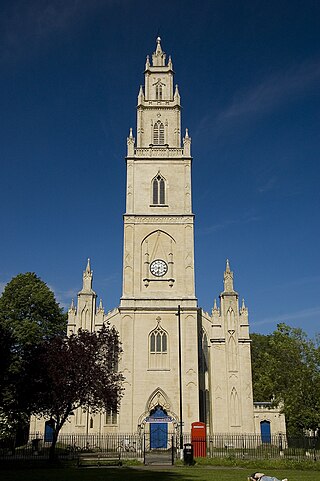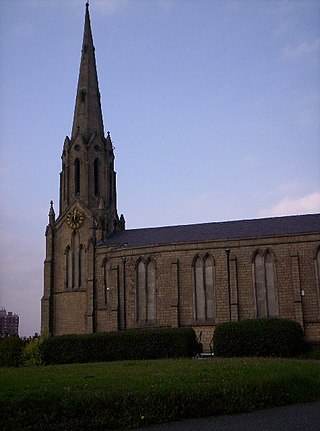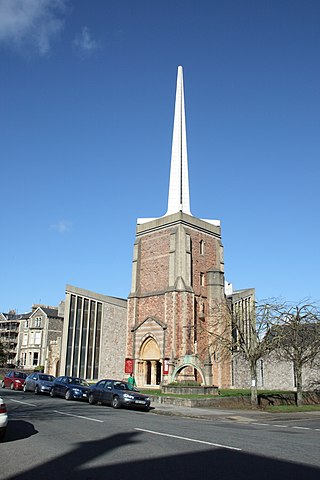
Sir George Gilbert Scott, largely known as Sir Gilbert Scott, was a prolific English Gothic Revival architect, chiefly associated with the design, building and renovation of churches and cathedrals, although he started his career as a leading designer of workhouses. Over 800 buildings were designed or altered by him.

St Walburge's Church is a Roman Catholic church in Preston, Lancashire, England, northwest of the city centre on Weston Street. The church was built in the mid-19th century to a design by the Gothic Revival architect Joseph Hansom, the designer of the hansom cab, and is famous as having the tallest spire of any parish church in England. St Walburge's is recorded in the National Heritage List for England as a Grade I listed building.

Culham is a village and civil parish in a bend of the River Thames, 1 mile (1.6 km) south of Abingdon in Oxfordshire. The parish includes Culham Science Centre and Europa School UK. The parish is bounded by the Thames to the north, west and south, and by present and former field boundaries to the east. It is low-lying and fairly flat, rising from the Thames floodplain in the south to a north-facing escarpment in the north up to 260 feet (80 m) above sea level. The 2011 Census recorded its population as 453.

Edward Blore was a 19th-century English landscape and architectural artist, architect and antiquary.

Bristol, the largest city in South West England, has an eclectic combination of architectural styles, ranging from the medieval to 20th century brutalism and beyond. During the mid-19th century, Bristol Byzantine, an architectural style unique to the city, was developed, and several examples have survived.

St Paul's Church, a redundant church, gives its name to the surrounding St Paul's area of Bristol, England. It was built in the 1790s but fell into disuse and disrepair by its closure in 1988. It is recorded in the National Heritage List for England as a designated Grade I listed building.

Christ Church with St Ewen is a Church of England parish church in Broad Street, Bristol, England.

Church of Holy Trinity is an Anglican church in Hotwells, Bristol, England. It has been designated as a grade II* listed building.

St Peter's is a Neo Norman style church in Bishopsworth, Bristol, England.

St Thomas the Martyr is a former Church of England parish church on St Thomas Street in the Redcliffe district of the English port city of Bristol.

All Saints' Church is the parish church of Runcorn, Cheshire, England, sited on the south bank of the River Mersey overlooking Runcorn Gap. There is a tradition that the first church on the site was founded by Ethelfleda in 915. That was replaced, probably in about 1250, by a medieval church that was altered and extended in the 14th and 15th centuries. By the 19th century the building's structure had deteriorated and become dangerous, and it was replaced by a new church, built between 1847 and 1849 to the designs of Anthony Salvin.

St Michael's Church is in the town of Kirkham, Lancashire, England. The church is recorded in the National Heritage List for England as a designated Grade II* listed building. It is an active Anglican parish church in the diocese of Blackburn, the archdeaconry of Lancaster and the deanery of Kirkham.

St Catharine's Church is in Lorne Street, Scholes, Wigan, Greater Manchester, England. It is an active Anglican parish church in the deanery of Wigan, the archdeaconry of Warrington and the diocese of Liverpool. Its benefice is united with that of Christ Church, Ince-in-Makerfield. The church is recorded in the National Heritage List for England as a designated Grade II listed building. It was a Commissioners' church, having received a grant towards its construction from the Church Building Commission.

Christ Church is an Anglican church in the Ore area of the town and borough of Hastings, one of six local government districts in the English county of East Sussex. It is one of three Anglican churches with this dedication in the borough. The Decorated Gothic-style church, in the centre of a village which has been surrounded by suburban development, was built in 1858 to supplement Ore's parish church, St Helen's. The most distinctive structural feature, a corner bell turret, has been described as both "outstanding" and "very naughty" by architectural historians. English Heritage has listed the building at Grade II for its architectural and historical importance.

John Norton was an English architect who designed country houses, churches and a number of commercial buildings.

Christ Church is an Anglican church in Wesham, a small town in the English county of Lancashire. It is an active parish church in the Diocese of Blackburn and the archdeaconry of Lancaster. It was built 1893–94 by Paley, Austin and Paley, and is recorded in the National Heritage List for England as a designated Grade II listed building.

St Luke's Church is on Liverpool Road, near the centre of Great Crosby, Sefton, Merseyside, England. It is an active Anglican parish church in the diocese of Liverpool. The church is recorded in the National Heritage List for England as a designated Grade II listed building. The east end of the church was rebuilt following a fire in 1972.

The Church of All Saints is a Church of England parish church in Clifton, Bristol. The church is a grade II listed building. It is located in the Parish of All Saints with St. John Clifton in the Diocese of Bristol.

Christ Church is a Church of England parish church in Kilndown, Kent, England. It was built in 1839 under the commission of William Beresford, 1st Viscount Beresford, and was substantially reordered in the early 1840s in accordance with the principles of the Cambridge Camden Society. Its layout and rich interior decoration, contributed by a range of major architects of the era, made it "a showcase" of the influential Society's ideas: John Betjeman described the church as "a museum of the Camden Society". It was severely damaged by bombing during the Second World War, but has been restored. It is a Grade I listed building.





















